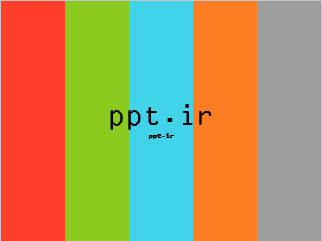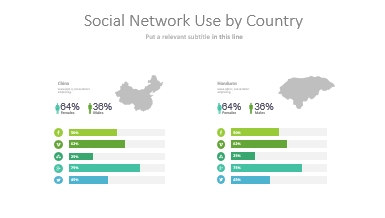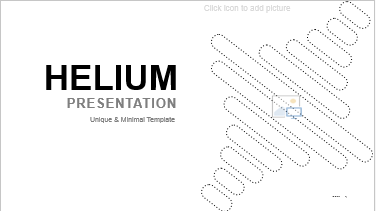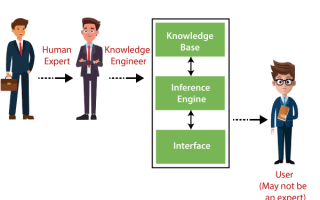Fuzzy Inference systems
اسلاید 1: Fuzzy Inference Systems主講人: 虞台文
اسلاید 2: ContentThe Architecture of Fuzzy Inference SystemsFuzzy Models:Mamdani Fuzzy modelsSugeno Fuzzy ModelsTsukamoto Fuzzy modelsPartition Styles for Fuzzy Models
اسلاید 3: Fuzzy Inference SystemsThe Architecture ofFuzzy Inference Systems
اسلاید 4: Fuzzy SystemsFuzzy Knowledge baseInputFuzzifierInferenceEngineDefuzzifierOutput
اسلاید 5: Fuzzy Control SystemsFuzzy Knowledge baseFuzzifierInferenceEngineDefuzzifierPlantOutputInput
اسلاید 6: FuzzifierConverts the crisp input to a linguistic variable using the membership functions stored in the fuzzy knowledge base.
اسلاید 7: FuzzifierConverts the crisp input to a linguistic variable using the membership functions stored in the fuzzy knowledge base.
اسلاید 8: Inference EngineUsing If-Then type fuzzy rules converts the fuzzy input to the fuzzy output.
اسلاید 9: DefuzzifierConverts the fuzzy output of the inference engine to crisp using membership functions analogous to the ones used by the fuzzifier.
اسلاید 10: NonlinearityIn the case of crisp inputs & outputs, a fuzzy inference system implements a nonlinear mapping from its input space to output space.
اسلاید 11: Fuzzy Inference SystemsMamdaniFuzzy models
اسلاید 12: Mamdani Fuzzy modelsOriginal Goal: Control a steam engine & boiler combination by a set of linguistic control rules obtained from experienced human operators.
اسلاید 13: The Reasoning SchemeMax-Min Composition is used.
اسلاید 14: The Reasoning SchemeMax-Product Composition is used.
اسلاید 15: DefuzzifierConverts the fuzzy output of the inference engine to crisp using membership functions analogous to the ones used by the fuzzifier.Five commonly used defuzzifying methods:Centroid of area (COA)Bisector of area (BOA)Mean of maximum (MOM)Smallest of maximum (SOM)Largest of maximum (LOM)
اسلاید 16: Defuzzifier
اسلاید 17: Defuzzifier
اسلاید 18: ExampleR1 : If X is small then Y is smallR2 : If X is medium then Y is mediumR3 : If X is large then Y is largeX = input [10, 10]Y = output [0, 10]Overall input-output curveMax-min composition and centroid defuzzification were used.
اسلاید 19: ExampleR1: If X is small & Y is small then Z is negative largeR2: If X is small & Y is large then Z is negative smallR3: If X is large & Y is small then Z is positive smallR4: If X is large & Y is large then Z is positive largeX, Y, Z [5, 5]Overall input-output curveMax-min composition and centroid defuzzification were used.
اسلاید 20: Fuzzy Inference SystemsSugenoFuzzy Models
اسلاید 21: Sugeno Fuzzy ModelsAlso known as TSK fuzzy model Takagi, Sugeno & Kang, 1985Goal: Generation of fuzzy rules from a given input-output data set.
اسلاید 22: Fuzzy Rules of TSK ModelIf x is A and y is B then z = f(x, y)Fuzzy SetsCrisp Functionf(x, y) is very often a polynomial function w.r.t. x and y.
اسلاید 23: ExamplesR1: if X is small and Y is small then z = x +y +1R2: if X is small and Y is large then z = y +3R3: if X is large and Y is small then z = x +3R4: if X is large and Y is large then z = x + y + 2
اسلاید 24: The Reasoning Scheme
اسلاید 25: ExampleR1: If X is small then Y = 0.1X + 6.4R2: If X is medium then Y = 0.5X + 4R3: If X is large then Y = X – 2X = input [10, 10]unsmooth
اسلاید 26: ExampleR1: If X is small then Y = 0.1X + 6.4R2: If X is medium then Y = 0.5X + 4R3: If X is large then Y = X – 2X = input [10, 10]If we have smooth membership functions (fuzzy rules) the overall input-output curve becomes a smoother one.
اسلاید 27: ExampleR1: if X is small and Y is small then z = x +y +1R2: if X is small and Y is large then z = y +3R3: if X is large and Y is small then z = x +3R4: if X is large and Y is large then z = x + y + 2X, Y [5, 5]
اسلاید 28: Fuzzy Inference SystemsTsukamotoFuzzy models
اسلاید 29: Tsukamoto Fuzzy modelsThe consequent of each fuzzy if-then-rule is represented by a fuzzy set with a monotonical MF.
اسلاید 30: Tsukamoto Fuzzy models
اسلاید 31: ExampleR1: If X is small then Y is C1R2: If X is medium then Y is C2R3: if X is large then Y is C3
اسلاید 32: Fuzzy Inference SystemsPartition Styles for Fuzzy Models
اسلاید 33: Review Fuzzy ModelsIf <antecedence> then <consequence>.The same style for Mamdani Fuzzy models Sugeno Fuzzy Models Tsukamoto Fuzzy modelsDifferent styles for Mamdani Fuzzy models Sugeno Fuzzy Models Tsukamoto Fuzzy models
اسلاید 34: Partition Styles for Input SpaceGridPartitionTreePartitionScatterPartitio














نقد و بررسی ها
هیچ نظری برای این پاورپوینت نوشته نشده است.